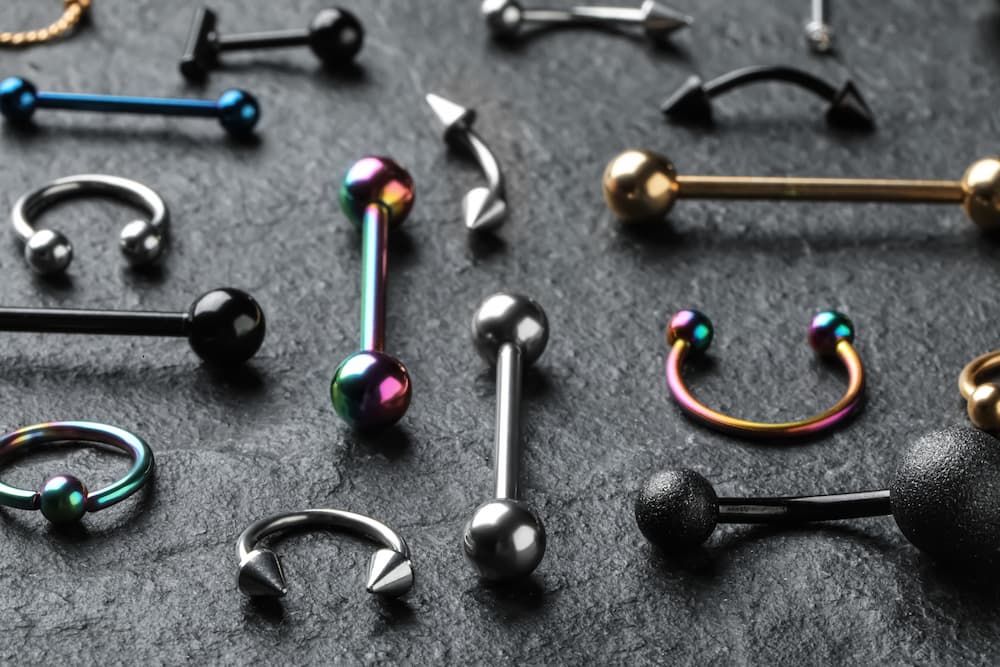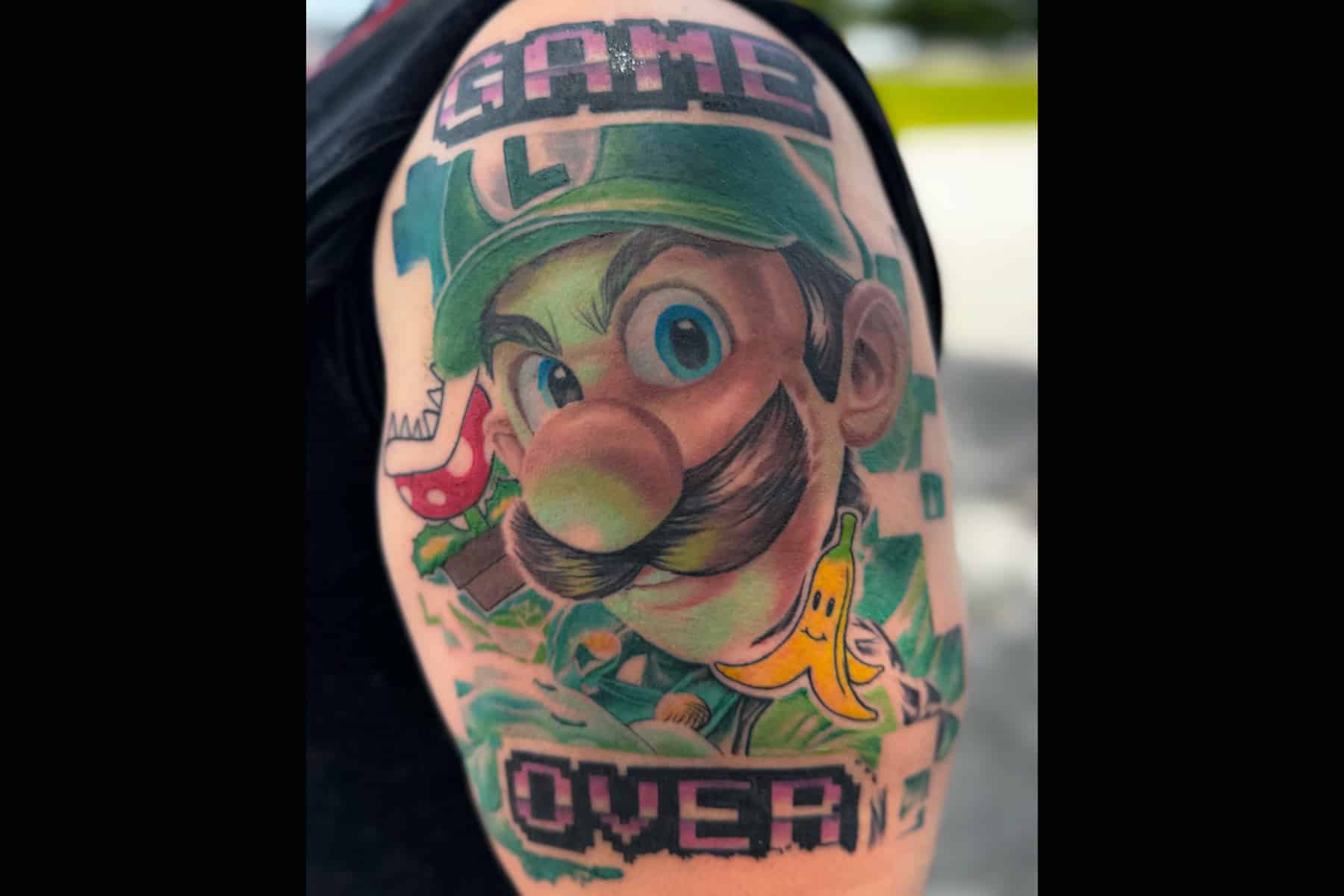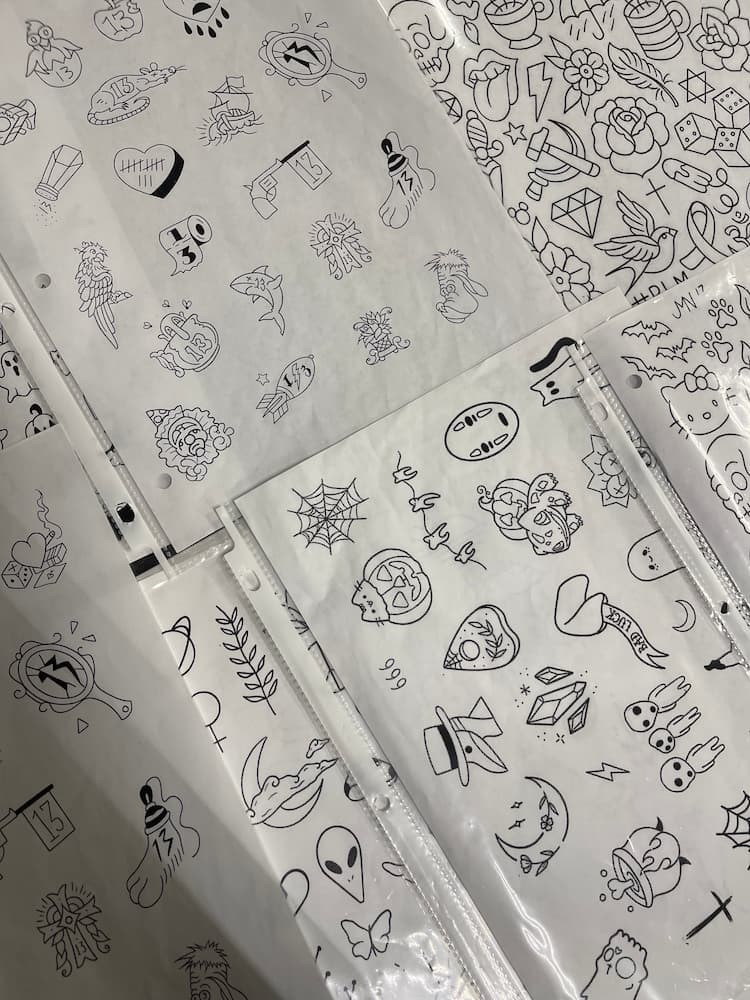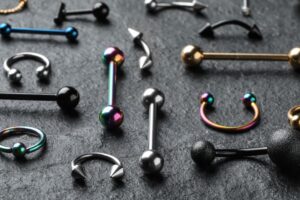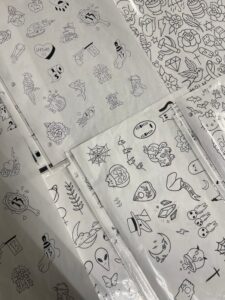Tattoo and piercing artists rely on various specialized equipment to create intricate designs and perform safe procedures. Each tool serves a unique purpose in the process, from tattoo machines to piercing needles. Tattooing has been around for roughly 5,000 years and the techniques used have transformed tremendously, especially in the last twenty years. According to a Pew Research Center survey, 32% of adults have a tattoo and 22% have more than one.
But how has ink changed over this vast amount of time? What tools do artists use to create those fine lines, exquisite details, and seamless shading?
Good Vibrations Ink is going to reveal the tools of our trade. From the buzzing tattoo machines to the delicate piercing needles, we’re giving you an insider’s look at the equipment that fuels our passion for creativity and expression.
What Tools Do Piercers Use?
The Association of Professional Piercers strongly advocates using sterile disposable equipment for body piercing procedures. Following their lead, Good Vibrations Ink only uses sterile, disposable equipment or implant-grade ASTM F138 steel and titanium for body piercings.
What Is The Difference Between A Piercing Gun And A Piercing Instrument?
It’s generally believed that piercing guns are quick and convenient. However, there are risks with other shops using reusable piercing guns, especially regarding the sterility of the equipment, potential tissue damage, and unsuitable jewelry. Piercings performed with sharp surgical-grade needles cause less tissue separation and trauma, minimizing the risk of complications (like excessive scarring or lumps of tissue).
Do Piercings Hurt More With A Gun Or Needle?
Ear-piercing studs may look slightly sharp, but they are actually quite blunt. When they puncture the skin, they cause more of a crushing injury than a clean piercing, resulting in similar tissue damage. This trauma can cause pain, swelling and, in extreme cases, tissue disfigurement such as auricular chondritis, especially when used on structural tissue like cartilage.
Sharp surgical needles, on the other hand, slide smoothly through the tissue and cause less separation. Piercers use a post-pressure technique to minimize scar formation.
Can I Use Any Type Of Jewelry For A Piercing?
Only implant-grade steel and titanium are considered appropriate for piercing jewelry. Other materials, even if they have surface plating, should not be used. Jewelry that fits too closely can increase the risk of infection because it traps body fluids around the piercing, creating a breeding ground for bacteria. This can lead to secondary infections if not cleaned thoroughly and frequently. Implant-grade jewelry is designed for easy cleaning and long-term wear, helping to prevent these issues.
What Tattoo Machine Do Artists Use?
There are two main machines that tattoo artists use – coil and rotary. Coil machines are the most common and are recognized by their loud buzzing sound. They give artists great control and customization during sessions like shaders, liners, and color packers. Rotary machines are quieter, lighter, and cause less cramping for artists.
Coil Tattoo Machine
Coil tattoo machines date back to 1891. Powered by electricity, these machines use coils to generate an electromagnetic charge that propels the needle in a hammering motion to deliver ink into the skin. Coil machines are bulkier than rotary machines because of the complex internal components (coils, iron rods, springs, and contact posts).
The electromagnetic circuit initially seems choppy but skilled artists often appreciate the precision and control coil machines provide. They typically use separate machines that have been customized for lining and shading. Coil machines have a history of tradition and required expertise, which some artists prefer.
Rotary Tattoo Machine
In recent years, rotary machines have grown in popularity, especially with new pen-style designs that offer artists a comfortable, marker-like grip. The motor mechanism moves in a circular motion, translating into consistent linear movement. This consistency helps artists achieve a smoother, quieter tattoo experience and precise lining, shading, and color packing. The quieter session reduces strain for the artist and creates a more comfortable setting for clients who may be sensitive to loud, long buzzing sounds.
Rotary machines require less power, making them suitable for battery operation and eliminating the need for cable maintenance and multiple outlets. They use disposable ink cartridges which simplifies the setup and maintenance process. Rotary machines have sealed housing and minimal moving parts, making cleaning easy.
Types of Tattoo Ink
Tattoo inks can be broken down into carriers and colorants, with carriers as the fluid medium transporting colorants to the skin. The color of the ink comes from light reflection or absorption by the particles and dyes. Historically, colorants were derived from mineral or geological sources (such as carbon, iron oxide, and cadmium) to produce various hues.
Today, more than 200 colorants and additives are used to produce tattoo inks. Despite the diversity of colorants and additives, tattoo inks are typically a mixture of solid pigment particles, molecular dyes, and binders suspended in a water-based solution (such as glycerin, water, isopropyl alcohol or witch hazel).
Tattoo inks are surprisingly under-regulated by government authorities. The U.S. Food and Drug Administration (FDA) generally refrains from active oversight unless specific safety concerns come up. The FDA has a fact sheet that provides more information about tattoo inks.
What’s the Difference Between Powder and Homogenized Ink?
There are various types of tattoo inks, each with its own characteristics and suitability for specific tattooing styles and outcomes. One distinction lies in the form of the ink: powder pigments versus homogenized colors.
- Powder pigments are pure colorants that are mixed with a carrier fluid to create the liquid ink used in tattooing.
- Homogenized colors are pre-mixed, full-strength, concentrated colors that do not require further mixing with a carrier fluid.
The choice between these types of ink can impact color consistency, tattoo longevity, and ease of use for the artist. Homogenized colors offer convenience and consistency but can lack the versatility of custom mixing that powder pigments provide.
A common question our artists at Good Vibrations Ink get is How do you make tattoo ink pop?
There are several factors that come into play beyond just the type of ink used when getting ink to pop. High-quality pigments and well-homogenized ink contribute to vibrant and long-lasting colors. Additional considerations include:
- Existing Allergies – If you are allergic to nickel, you should avoid inks containing this ingredient. Some tattoo inks can cause allergic reactions in individuals with sensitive skin.
- UV resistance – With time, all tattoos will fade to some extent. However, the speed of fading hinges on the ink’s quality, the tattoo’s exposure to UV light (sun), and how you care for your tattoo during the healing phase.
- Healing properties – Some tattoo inks are chemically designed to promote faster healing, reduce scabbing and minimize infection risks.
- Blending capabilities – Blending is mixing different ink colors to create new shades or gradients. It can be done in the ink cap or directly within the cartridge. Blending ink colors from the same brand is best to ensure consistent results.
How Ink Stays In Skin
The skin comprises three layers: the epidermis, the dermis, and the subcutaneous tissue. The middle layer, the dermis, is where tattoo ink holds best. You may notice your artist dip the needle in water during the session. This is called a dip cap which helps clean, blend, dry, or dilute ink. Artists do this for smoother ink flow and to reduce friction. This allows more precise and comfortable tattooing.
Good Vibrations Ink only uses the highest quality tattoo ink. Our black, grey and color sets come from World Famous Ink, Sacred Tattoo Ink, RAW Pigments, and Eternal Ink.
There is a delicate balance between needle size, depth, and arrangement that artists take during sessions (we will go over these later). If they go too shallow, the ink won’t reach into the dermis and may face prematurely. If they go too deep, the ink can spread into the subcutaneous tissue and create blurred lines or ink spread.
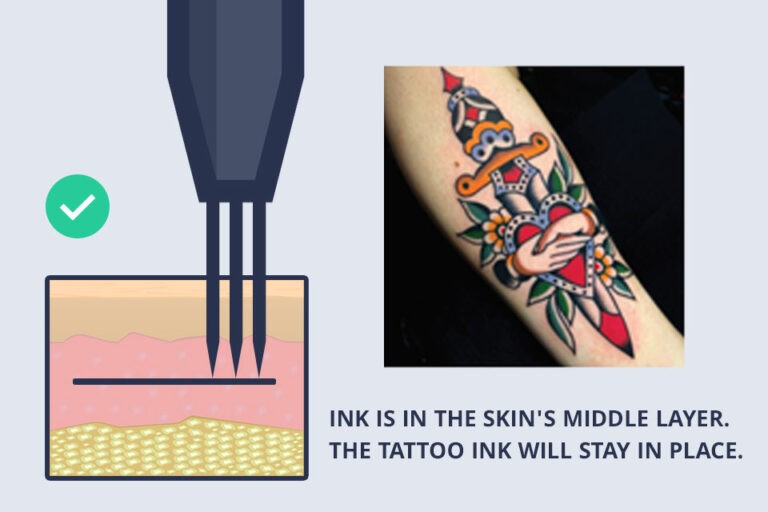
Using the right products for your skin during (and specifically after) the tattoo session is important. Good Vibrations Ink recommends using IKONIK’s skincare products before, during, and after your tattoo to get the best tattoo results. Our artists use Cosmik Soap to clean the area of skin they’ll be working on and the Stoik Spray to numb the skin and reduce pain. To keep your skin hydrated and encourage proper healing afterward, apply Epik Cream 2 – 4 times daily.
Tattoo Needles
Needles are just as important as the ink that’s used. Different configurations, types, and sizes significantly impact how the tattoo will look and stay in the skin. It’s one of the keys that make the machine work with the artist or fight against their creative ability.
There are four commonly used groupings of needles. Using closer grouping, known as “Tights,” makes finer lines, whereas wider groupings, like “loose” or “turbo,” create bolder lines. The needle count, the second number on a needle packet, indicates how many needles are grouped together and attached to the needle bar.
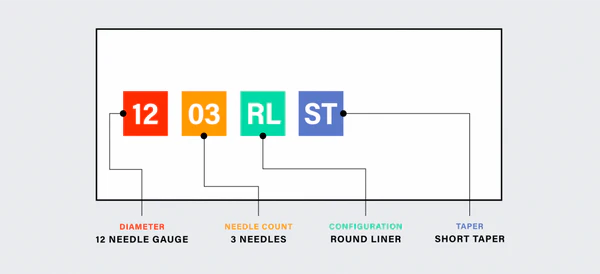
Tattoo Needle Configurations
Needles are interchangeable on tattoo machines, allowing artists to customize their work with preferred arrangements that suit their desired outcome. There are many different needle styles and configurations that fall into four configurations:
- Round Liner – are circular groupings of needles clustered into a point that artists typically use for lining (bold or fine). Use a medium taper liner for more skin contact (bolder, fatter lines) and a longer taper for thinner lines.
- Round Shader – contains a circular cluster of needles used for shading small areas, filling in color, blending and shading a tattoo. There’s more space between each pin for increased ink flow than liner needles. Medium taper shaders are typically used for color work while long taper shaders are more commonly used for black and grey work.
- Magnum – arranged in two rows of needles stacked flat on top of one another, these have a larger open taper used for lining and shading. This configuration is usually used for wider skin coverage requiring solid work or heavy color packing.
- Curved Magnum – used for both lining and shading, this needle configuration has edges with a shorter taper, making them curved. Tattoo artists can adjust or move them to create different ink effects.
Tattoo Needle Diameter, Taper, and Needle Count
Diameters
Tattoo needle sizes dictate the precision, depth, and style of the ink deposited into the skin. The first two numbers on a needle packet indicate the diameter of the needle which directly influences ink flow. Narrower diameters, such as the 0.25mm (#08) needles, produce fine lines with high control of ink flow. This makes them ideal for intricate line work and fine details.
There are three common diameters tattoo artists typically use:
- 0.25mm (#08)
- 0.30mm (#10)
- 0.35mm (#12)
Larger tattoos are typically created with larger diameter needles for shades or color-dense areas. Larger diameters, like the 0.35mm (#12) needles, have a more open flow of ink, which is beneficial for shading and bold, solid lines.
Taper Lengths
Taper lengths range from 0.25mm – 0.60mm and determine the thickness of lining or shading. Shorter taper lengths (standard (short) taper of 1.5mm) are often used for lining and creating crisp and defined edges. Longer taper lengths (3.5mm) are typically used for shading. Finer needle points achieve smoother gradients and softer transitions between colors.
The most common taper sizes are:
- Standard (short) taper: 1.5mm
- Long Taper: 2.0mm
- Double Long Taper: 2.5mm
- Extra Long Taper: 3.5mm
- Super Long Taper: 5.5mm
- Super Extra Long Taper: 8.0mm
Textures
Smooth needles are the standard because they create clean and precise lines. This makes them suitable for any ink type. Textured needles have grooved tapers, creating a dimpling effect along the needle to hold more ink. This effect reduces the frequency that an artist needs to replenish ink during a session, especially when it comes to shading and blending.
Needles With An Ink Cartridge
Tattoo needle cartridges have a membrane that prevents liquids from entering the grip, tube, and tattoo machine. This adds a safety and sterile solution to protect equipment from contact with germs, bacteria, and viruses. Because of the seals, tattoo machines only need to be disinfected between uses and reduces the need to autoclave between sessions.
Tattoo Sterility
Having a sterile environment for tattoo and piercings cannot be overstated, especially since tattoo machines comes into direct contact with the client and are reused for multiple customers. This is a safety precaution for both the artist and the client. Good Vibrations Ink adheres to strict cleaning and sterilzation procedures to prevent cross-contamination and the spread of germs or infections.
There is a distinct difference between sterilization and disinfection. Disinfecting a work station does decontaminate the area and kills most viruses and fungi, but not all bacteria. Sterilization completely destroys microorganisms.
We use autoclaves to sterilize most of our equipment, eliminating bacteria and viruses. Autoclaves are the most common piece of sterilization equipment in tattoo and piercing shops. They reduce the risk of contamination to 0.0001%. These machines use a combination of high pressure, heat, and steam. However, not all tattoo equipment can be autoclaved (due to size or mechanics – like the motor of tattoo machines), so cold sterilization is necessary.
Unfortunately, plastics and electronics cannot be sterilized in autoclaves.
Autoclaves are the simplest (and arguably best) tool for tattoo and piercing shops and come in a variety of sizes with varying features. They use pressurized steam to destroy microorganisms, making them ideal for sterilizing metallic body jewelry, forceps, tattoo grips, and tubes.
Transform Your Body Art Dreams Into Reality With Good Vibrations Ink
Whether you’re looking to express your individuality through a stunning tattoo or add a stylish piercing to your collection, Good Vibrations Ink is the place to be. Our team of award-winning artists and piercers combines talent with professionalism to deliver results that exceed expectations. We are committed to safety, hygiene, customer satisfaction, and good vibes only. Schedule an appointment with one of our skilled artists or piercers and let us help you make a statement that lasts a lifetime.


